MCP-1/CCR2B-dependent loop upregulates MUC5AC and MUC5B in human airway epithelium
- PMID: 21097527
- PMCID: PMC3043814
- DOI: 10.1152/ajplung.00292.2010
MCP-1/CCR2B-dependent loop upregulates MUC5AC and MUC5B in human airway epithelium
Abstract
Cigarette smoke represents a major risk factor for the development of chronic obstructive pulmonary disease (COPD), a respiratory condition associated with airflow obstruction, mucus hypersecretion, chronic inflammation, and upregulation of inflammatory mediators such as the monocyte chemotactic protein-1 (MCP-1). MCP-1 through its receptor CCR2 induces chemotaxis and activates (44/42)MAPK, a kinase known to play a key role in mucin regulation in bronchial epithelium. In the present study we used differentiated primary cultures of normal human bronchial epithelial (NHBE) cells to test whether MCP-1 through its receptor CCR2 induces mucin upregulation. We have provided evidence that NHBE cells release MCP-1 to the epithelial surface and express the CCR2B isoform of the receptor mainly at the apical pole. In addition, we found that MCP-1 has a novel function in airway epithelium, increasing the two major airway mucins MUC5AC and MUC5B, an effect mediated, at least in part, by a cascade of events initiated by interaction of its receptor CCR2B with G(q) subunits in caveolae, followed by PLCβ, PKC, and (44/42)MAPK activation. We also have shown that MCP-1 is able to induce its own expression using the same receptor but through a different pathway that involves RhoA GTPase. Furthermore, we found that a single exposure to MCP-1 is enough to induce MCP-1 secretion and sustained mucin upregulation up to 7 days after initial exposure, an effect mediated by CCR2B as confirmed using short hairpin RNA. These results agree with our data in smoker's airway epithelium, where CCR2B is present in MUC5AC- and MUC5B-expressing cells and augmented MCP-1 expression is associated with increased MUC5AC and MUC5B immunolabeling, suggesting that the mechanisms described in primary cell cultures in the present study are operative in vivo. Therefore, therapeutic approaches targeting MCP-1/CCR2B may be useful in preventing not only influx of inflammatory cells to the airways but also mucus hypersecretion and goblet cell hyperplasia.
Figures
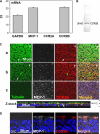


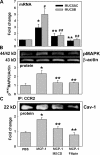
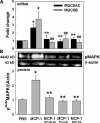

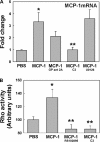
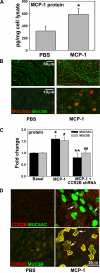


Similar articles
-
MUC5AC expression is increased in bronchial submucosal glands of stable COPD patients.Histopathology. 2009 Sep;55(3):321-31. doi: 10.1111/j.1365-2559.2009.03377.x. Histopathology. 2009. PMID: 19723147
-
Diesel exhaust particles elevate MUC5AC and MUC5B expression via the TLR4-mediated activation of ERK1/2, p38 MAPK, and NF-κB signaling pathways in human airway epithelial cells.Biochem Biophys Res Commun. 2019 Apr 23;512(1):53-59. doi: 10.1016/j.bbrc.2019.02.146. Epub 2019 Mar 8. Biochem Biophys Res Commun. 2019. PMID: 30857636
-
β2-Adrenoceptor involved in smoking-induced airway mucus hypersecretion through β-arrestin-dependent signaling.PLoS One. 2014 Jun 6;9(6):e97788. doi: 10.1371/journal.pone.0097788. eCollection 2014. PLoS One. 2014. PMID: 24905583 Free PMC article.
-
Impact of N-Acetylcysteine on Mucus Hypersecretion in the Airways: A Systematic Review.Int J Chron Obstruct Pulmon Dis. 2024 Oct 29;19:2347-2360. doi: 10.2147/COPD.S474512. eCollection 2024. Int J Chron Obstruct Pulmon Dis. 2024. PMID: 39493366 Free PMC article.
-
Emerging cell and molecular targets for treating mucus hypersecretion in asthma.Allergol Int. 2024 Jul;73(3):375-381. doi: 10.1016/j.alit.2024.04.002. Epub 2024 May 1. Allergol Int. 2024. PMID: 38692992 Free PMC article. Review.
Cited by
-
Effects of aging and smoking on carotid intima-media thickness in HIV-infection.AIDS. 2013 Jan 2;27(1):49-57. doi: 10.1097/QAD.0b013e328358b29c. AIDS. 2013. PMID: 22874518 Free PMC article.
-
Interplay of extracellular matrix and leukocytes in lung inflammation.Cell Immunol. 2017 Feb;312:1-14. doi: 10.1016/j.cellimm.2016.12.003. Epub 2016 Dec 23. Cell Immunol. 2017. PMID: 28077237 Free PMC article. Review.
-
Hypercapnia Inhibits Autophagy and Bacterial Killing in Human Macrophages by Increasing Expression of Bcl-2 and Bcl-xL.J Immunol. 2015 Jun 1;194(11):5388-96. doi: 10.4049/jimmunol.1500150. Epub 2015 Apr 20. J Immunol. 2015. PMID: 25895534 Free PMC article.
-
MiR-146a negatively regulates neutrophil elastase-induced MUC5AC secretion from 16HBE human bronchial epithelial cells.Mol Cell Biochem. 2011 Dec;358(1-2):249-55. doi: 10.1007/s11010-011-0975-2. Epub 2011 Jul 20. Mol Cell Biochem. 2011. Retraction in: Mol Cell Biochem. 2024 Dec;479(12):3491. doi: 10.1007/s11010-024-05103-z. PMID: 21773870 Retracted.
-
Regulation of Monocyte Chemotactic Protein-1 secretion by the Two-Pore-Domain Potassium (K2P) channel TREK-1 in human alveolar epithelial cells.Am J Transl Res. 2013 Aug 15;5(5):530-42. eCollection 2013. Am J Transl Res. 2013. PMID: 23977412 Free PMC article.
References
-
- Cigarette smoking among adults—United States, 1992, and changes in the definition of current cigarette smoking. MMWR Morb Mortal Wkly Rep 43: 342–346, 1994 - PubMed
-
- Ashida N, Arai H, Yamasaki M, Kita T. Distinct signaling pathways for MCP-1-dependent integrin activation and chemotaxis. J Biol Chem 276: 16555–16560, 2001 - PubMed
-
- Barnes PJ. New concepts in chronic obstructive pulmonary disease. Annu Rev Med 54: 113–129, 2003 - PubMed
-
- Budd DC, Willars GB, McDonald JE, Tobin AB. Phosphorylation of the Gq/11-coupled m3-muscarinic receptor is involved in receptor activation of the ERK-1/2 mitogen-activated protein kinase pathway. J Biol Chem 276: 4581–4587, 2001 - PubMed
Publication types
MeSH terms
Substances
Grants and funding
LinkOut - more resources
Full Text Sources
Molecular Biology Databases
Research Materials
Miscellaneous

